Its members refer to it as the Axis of Resistance.
It is the network of Iran-backed groups across the Middle East dedicated to reducing U.S. influence in the region and ultimately eliminating the state of Israel. The network’s name is a play on former President George W. Bush’s 2002 claim that Iran, Iraq and North Korea made up an Axis of Evil.
The Axis of Resistance includes Hamas, Hezbollah, the Houthis and other groups, and both its strategy and its tactics have long been radical. The official slogan of the Houthis — the Yemen-based group that has attacked commercial ships in the Red Sea — includes “death to America, death to Israel, a curse upon the Jews,” for example.
Nonetheless, the conflict between the Axis and its enemies had remained limited for years. Even though Iran funds and supports the Axis, other countries have often treated its member groups as distinct from Iran. Attacks by Hamas or Hezbollah usually did not lead to reprisals against Iran.
The events of the past few months threaten to change this dynamic. In today’s newsletter, I’ll explain why.
A murky distinction
The main turning point, of course, was Oct. 7. Hamas conducted the deadliest terrorist attack in Israel’s history and said it would repeat the attacks until Israel was destroyed. Israel has responded by vowing to destroy Hamas, and its war in Gaza has flattened neighborhoods and killed tens of thousands of Palestinians. In solidarity with Hamas, Hezbollah has fired missiles into Israel, while the Houthis have disrupted global commerce.
Initially, Iran remained somewhat removed from the fighting. Although its leaders praised the Oct. 7 attack as a step toward the end of Israel, they privately said they did not help plan the attack — and U.S. officials agree they did not. All three countries took steps to avoid a wider war.
All have good reasons. Iran’s economy is weak, and its fundamentalist government worries about pro-democracy activism. A war could destabilize the country. Israel eventually hopes to sign a diplomatic agreement with Saudi Arabia, as it already has with Bahrain, Morocco and the U.A.E., which would reduce the long-term risks to Israel’s existence. A bloody war could make it harder for the Saudis to do so (much as the war in Gaza has put the Saudi talks on hold). And President Biden very much wants to avoid a wider war.
Despite these factors, a basic reality may push Iran and Israel toward confrontation: The distinction between Iran and the Axis of Resistance has always been murky.
Hamas, Hezbollah and the Houthis could not exist as they do without the money and weapons they receive from Iran. Hezbollah is especially close with Iranian leaders. Iran, in short, makes possible an alliance that routinely attacks another country and calls for its demise.
This situation helps explain Israel’s bombing of an Iranian Embassy building in Syria on Monday, which killed several Iranian officials who helped oversee the relationship with the Axis of Resistance. The Oct. 7 attack left Israel feeling newly vulnerable, and it has become more aggressive in attacking Iranian officials (This Times article catalogs other recent Israeli attacks.) Monday’s was the starkest: Countries rarely attack embassies, even those of their enemies.
Iran has promised to retaliate, and U.S. officials are concerned that Americans may be targeted as well as Israelis, as my colleague Eric Schmitt notes. Experts are also worried that an Axis group could go further than its Iranian sponsors prefer.
The Suleimani case
I want to emphasize that escalation isn’t the only possible outcome. Iran and Israel both still have the same incentives to avoid a full-scale war, and officials from both countries are carefully calibrating their actions, according to Julian Barnes, a Times reporter who covers intelligence.
Recent history offers an example of an audacious attack that didn’t lead to spiraling violence. In 2020, a U.S. drone killed Maj. Gen. Qassim Suleimani, one of Iran’s most powerful officials, in Baghdad. The Trump administration said the assassination was punishment for Suleimani’s work with Axis of Resistance groups that had killed American troops in Iraq.
Afterward, many experts warned of a cycle of escalation. Instead, Iran retaliated in a limited way, and the U.S. did not respond. Today, though, the tensions between Iran and Israel are sharper than they have been in a long time.
More on the Middle East
The seat of modernism: An exhibition at the Museum of Modern Art, “Crafting Modernity,” explores modernism and domestic design in Latin America. It focuses on 1940 through 1980, a time of industrial expansion.
“I can’t recall the last time I coveted so many beautiful chairs,” Michael Kimmelman writes about the show. “The photographs give you some idea.”






